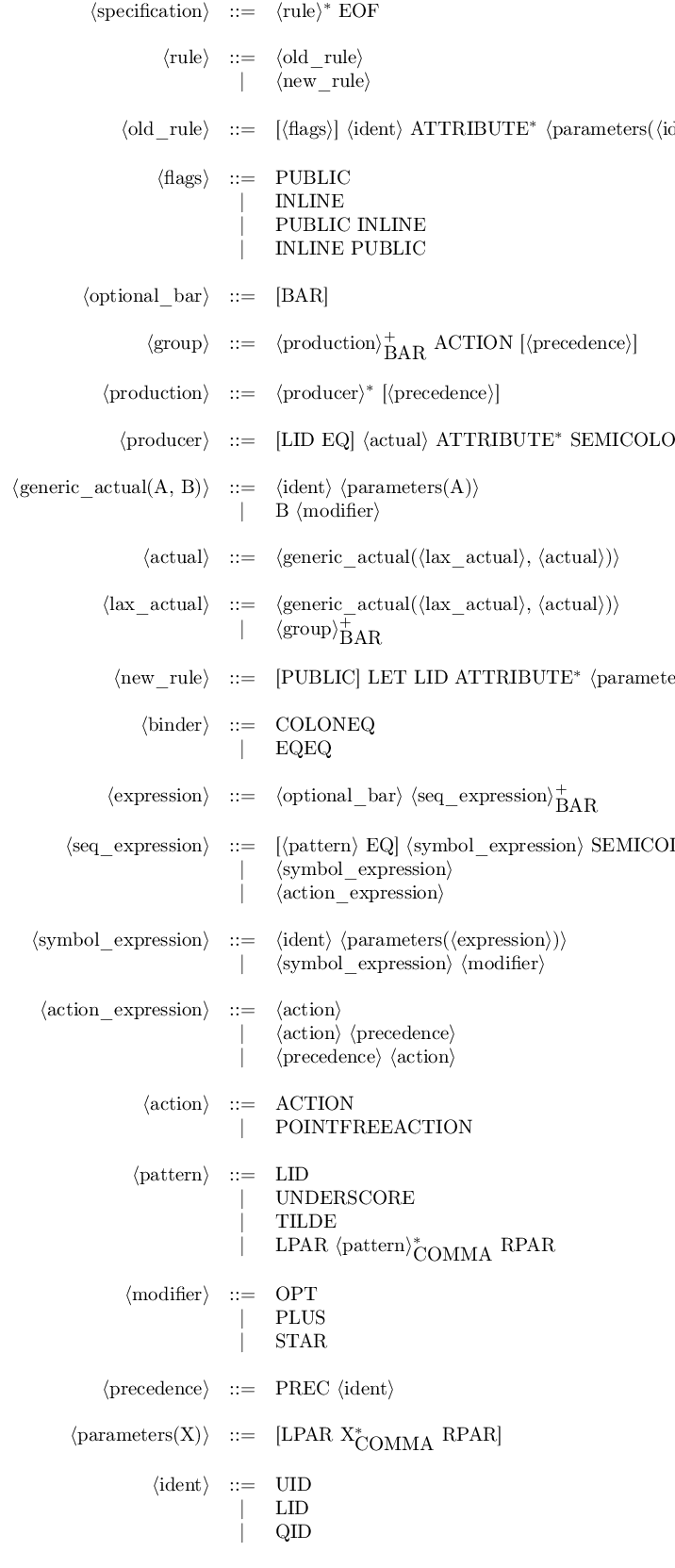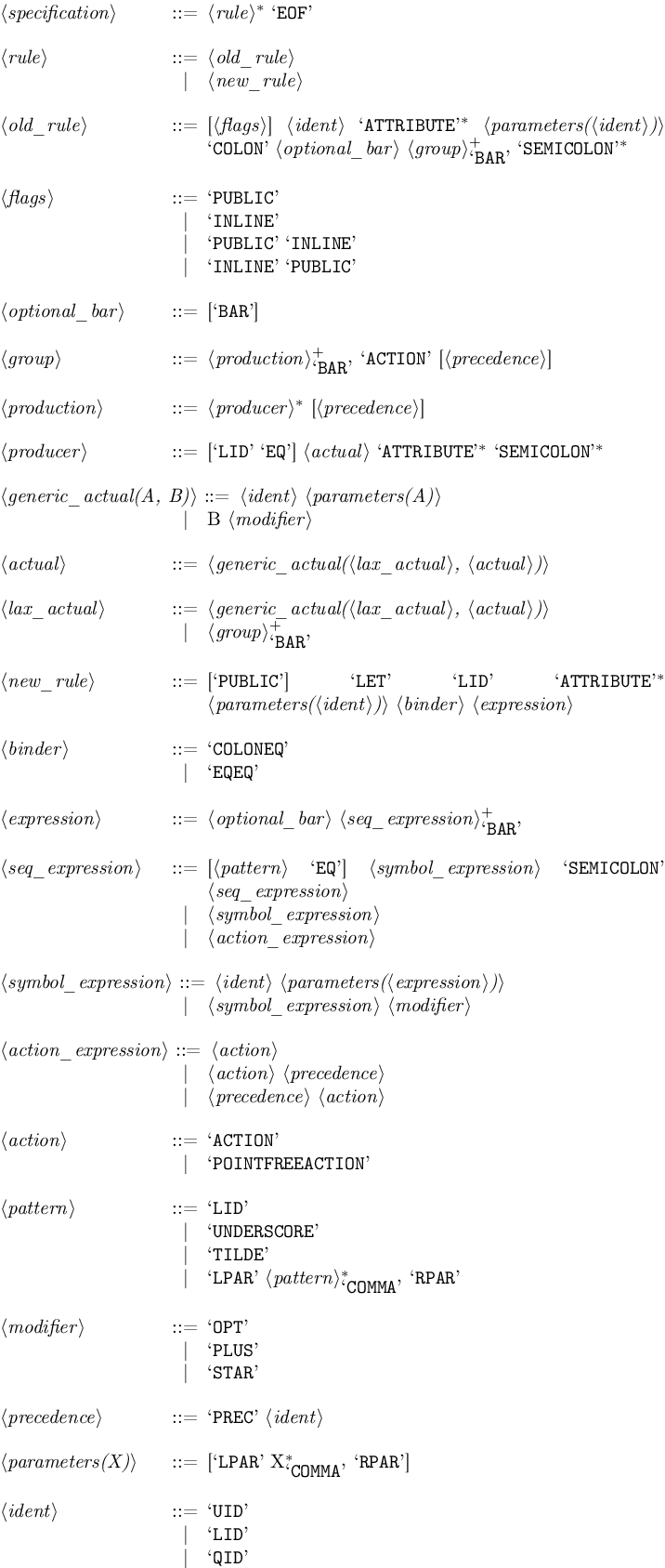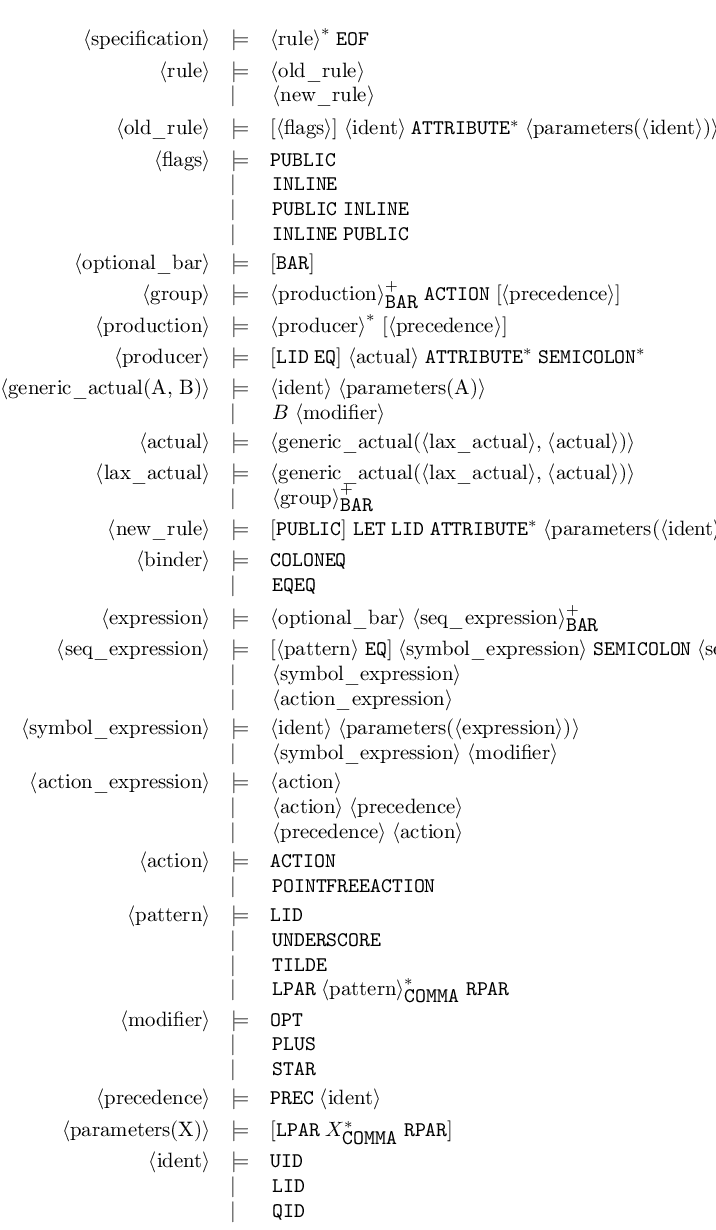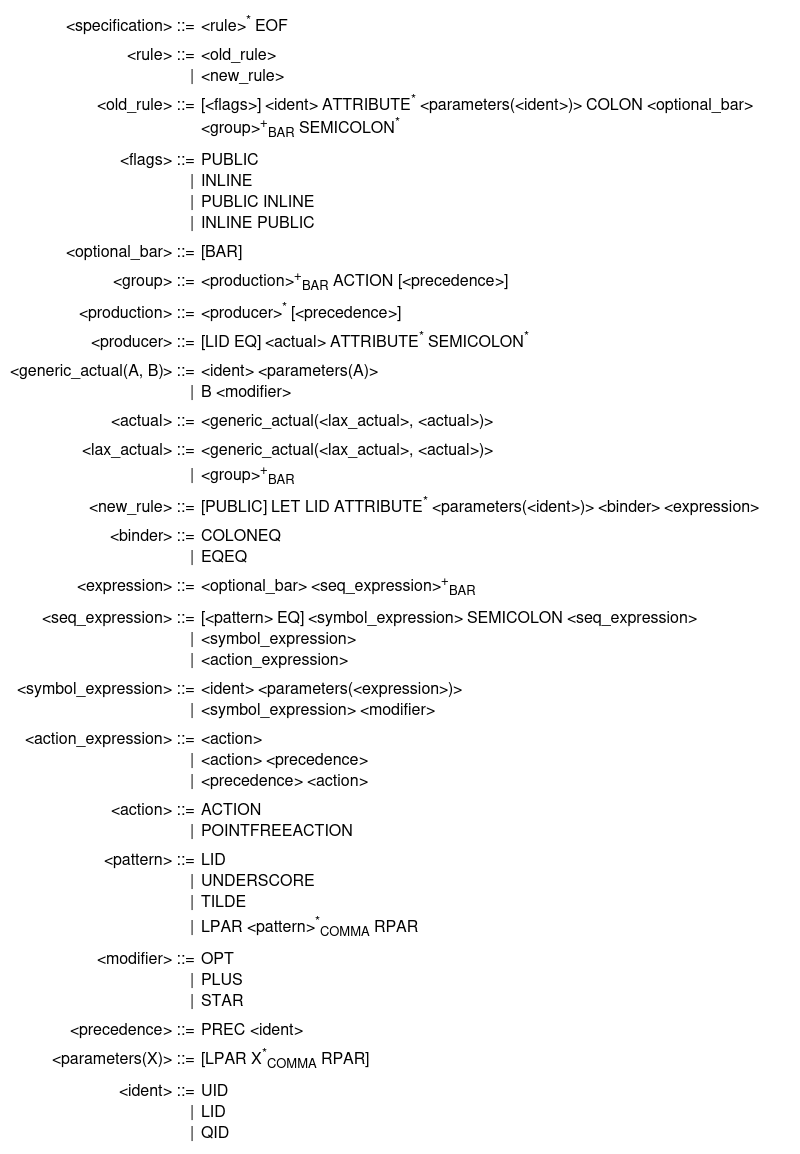Obelisk is a simple tool that produces pretty-printed output from a Menhir parser file (.mly).
It is inspired from yacc2latex and is also written in OCaml, but is aimed at supporting features from Menhir instead of only those of ocamlyacc.
The Makefile also uses imagemagick and wkhtmltopdf to build documentation images.
In addition to the package suffix, which is used to define starred commands, here is a summary of package dependencies for the different LaTeX modes:
If you use OPAM, simply type:
opam install obelisk
git clone to clone the Obelisk repository, then type:
dune build
This will provide you with an executable which you can feed .mly files with: dune exec src/main.exe -- <options> <file.mly>.
If you want to install Obelisk, you can type:
dune install [--prefix <the destination directory>]
obelisk [ebnf|latex|html] [options] <files>
If multiple files are specified, Obelisk will output a concatenated result without consistency checks. The user is responsible for avoiding, e.g. name clashes between the several files.
By default, Obelisk defaults to standard output; use -o <file> to specify an output file.
Obelisk can infer some common patterns (possibly parameterized):
- options
- lists and non-empty lists
- separated lists and non-empty separated lists
Once recognized, if the -i switch is specified, the rules are deleted, and their instances are replaced with default constructions (e.g. _*, _+, [_]).
Without the -i flag, only the productions of the recognized rules are replaced, and the total number of rules remains the same.
For example, on these simple rules (from this file):
my_option(X, Y):
| {}
| Y X {}
my_list(A):
| {}
| A my_list(A) {}
my_nonempty_list(C):
| C {}
| C my_nonempty_list(C) {}
my_separated_nonempty_list(X,Y):
| X {}
| X Y my_separated_nonempty_list(X,Y) {}
my_separated_list(X,S):
| {}
| my_separated_nonempty_list(X,S) {}
my_rule:
| my_option(E, F) {}
| my_list(E) {}
| my_nonempty_list(F) {}
| my_separated_nonempty_list(E,S1) {}
| my_separated_list(F,S2) {}
Obelisk (obelisk misc/reco.mly) outputs:
<my_option(X, Y)> ::= [Y X]
<my_list(A)> ::= A*
<my_nonempty_list(C)> ::= C+
<my_separated_nonempty_list(X, Y)> ::= X (Y X)*
<my_separated_list(X, S)> ::= [X (S X)*]
<my_rule> ::= <my_option(E, F)>
| <my_list(E)>
| <my_nonempty_list(F)>
| <my_separated_nonempty_list(E, S1)>
| <my_separated_list(F, S2)>
And with the -i switch (obelisk -i misc/reco.mly):
<my_rule> ::= [F E]
| E*
| F+
| E (S1 E)*
| [F (S2 F)*]
By default, the output format is a simple text format that is close to the BNF syntax.
You can use the subcommands ebnf, latex or html to get respectively an EBNF text output, LaTeX output or HTML output.
In default, EBNF and HTML mode, the option -noaliases avoid printing token aliases in the output.
In EBNF mode, parameterized rules are specialized into dedicated regular rules.
On the example above (obelisk ebnf misc/reco.mly):
my_rule ::= my_option_0
| my_list_0
| my_nonempty_list_0
| my_separated_nonempty_list_0
| my_separated_list_0
my_option_0 ::= (F E)?
my_nonempty_list_0 ::= F+
my_separated_nonempty_list_1 ::= F (S2 F)*
my_separated_list_0 ::= (F (S2 F)*)?
my_separated_nonempty_list_0 ::= E (S1 E)*
my_list_0 ::= E*
And with the -i switch (obelisk ebnf -i misc/reco.mly):
my_rule ::= (F E)?
| E*
| F+
| E (S1 E)*
| (F (S2 F)*)?
Use the following options to tweak the LaTeX:
-tabular: a tabular-based format from the tabu package (default)-syntax: use the syntax package-backnaur: use the backnaur package (not recommended: manual line-wrapping through this trick)
Either way, the output may be customized using LaTeX commands that you can redefine to fit your needs. The command names are auto-generated from the terminal names, and because of LaTeX limitations, underscores are removed, and numbers are converted into their Roman form.
By default, in LaTeX mode, the -o <grammar.tex> switch will produce the standalone LaTeX file <grammar.tex> which you can directly compile (e.g. with pdflatex).
But in conjunction with -o <grammar.tex>, you can use -package <definitions> to output two files:
- a LaTeX file <grammar.tex> containing only the grammar contents ;
- a package file <definitions.sty> (the .sty extension is added automatically) containing the necessary extra package requirements and command definitions.
These two files are then intended to be included in a user-provided main LaTeX file following this example skeleton:
\documentclass[preview]{standalone}
\usepackage{definitions}
\begin{document}
\include{grammar}
\end{document}To avoid name clashes, in particular when using the -package option and e.g. importing multiple grammars with the same LaTeX commands names, or in the case where one of the syntax construction names matches one already defined LaTeX macro, you can specify a common prefix for the commands with the option -prefix <myprefix>.
As end-beginning commands are forbidden in LaTeX, commands created from rules with names beginning with end are automatically prefixed with zzz.
The HTML file uses an internal CSS stylesheet that allows customizing the output (in a poorer way than in the latex mode).
The stylesheet uses content properties for some parts of the grammar by default (-css option) to make it modular and easily modifiable, but then some symbols are not treated as content and, for example, are not copy-pastable.
Use the -nocss option to disable the use of such properties.
Here are the outputs of the different formats obtained by Obelisk from its own [parser](src/parser. my).
<specification> ::= <rule>* EOF
<rule> ::= <old_rule>
| <new_rule>
<old_rule> ::= [<flags>] <ident> ATTRIBUTE* <parameters(<ident>)> COLON
<optional_bar> <group> (BAR <group>)* SEMICOLON*
<flags> ::= PUBLIC
| INLINE
| PUBLIC INLINE
| INLINE PUBLIC
<optional_bar> ::= [BAR]
<group> ::= <production> (BAR <production>)* ACTION [<precedence>]
<production> ::= <producer>* [<precedence>]
<producer> ::= [LID EQ] <actual> ATTRIBUTE* SEMICOLON*
<generic_actual(A, B)> ::= <ident> <parameters(A)>
| B <modifier>
<actual> ::= <generic_actual(<lax_actual>, <actual>)>
<lax_actual> ::= <generic_actual(<lax_actual>, <actual>)>
| <group> (BAR <group>)*
<new_rule> ::= [PUBLIC] LET LID ATTRIBUTE* <parameters(<ident>)> <binder>
<expression>
<binder> ::= COLONEQ
| EQEQ
<expression> ::= <optional_bar> <seq_expression> (BAR <seq_expression>)*
<seq_expression> ::= [<pattern> EQ] <symbol_expression> SEMICOLON
<seq_expression>
| <symbol_expression>
| <action_expression>
<symbol_expression> ::= <ident> <parameters(<expression>)>
| <symbol_expression> <modifier>
<action_expression> ::= <action>
| <action> <precedence>
| <precedence> <action>
<action> ::= ACTION
| POINTFREEACTION
<pattern> ::= LID
| UNDERSCORE
| TILDE
| LPAR [<pattern> (COMMA <pattern>)*] RPAR
<modifier> ::= OPT
| PLUS
| STAR
<precedence> ::= PREC <ident>
<parameters(X)> ::= [LPAR [X (COMMA X)*] RPAR]
<ident> ::= UID
| LID
| QID
specification ::= rule* EOF
rule ::= old_rule
| new_rule
old_rule ::= flags? ident ATTRIBUTE* parameters_0 COLON optional_bar group
(BAR group)* SEMICOLON*
flags ::= PUBLIC
| INLINE
| PUBLIC INLINE
| INLINE PUBLIC
optional_bar ::= BAR?
group ::= production (BAR production)* ACTION precedence?
production ::= producer* precedence?
producer ::= (LID EQ)? actual ATTRIBUTE* SEMICOLON*
actual ::= generic_actual_0
lax_actual ::= generic_actual_0
| group (BAR group)*
new_rule ::= PUBLIC? LET LID ATTRIBUTE* parameters_0 binder expression
binder ::= COLONEQ
| EQEQ
expression ::= optional_bar seq_expression (BAR seq_expression)*
seq_expression ::= (pattern EQ)? symbol_expression SEMICOLON seq_expression
| symbol_expression
| action_expression
symbol_expression ::= ident parameters_2
| symbol_expression modifier
action_expression ::= action
| action precedence
| precedence action
action ::= ACTION
| POINTFREEACTION
pattern ::= LID
| UNDERSCORE
| TILDE
| LPAR (pattern (COMMA pattern)*)? RPAR
modifier ::= OPT
| PLUS
| STAR
precedence ::= PREC ident
ident ::= UID
| LID
| QID
generic_actual_0 ::= ident parameters_1
| actual modifier
parameters_1 ::= (LPAR (lax_actual (COMMA lax_actual)*)? RPAR)?
parameters_0 ::= (LPAR (ident (COMMA ident)*)? RPAR)?
parameters_2 ::= (LPAR (expression (COMMA expression)*)? RPAR)?




